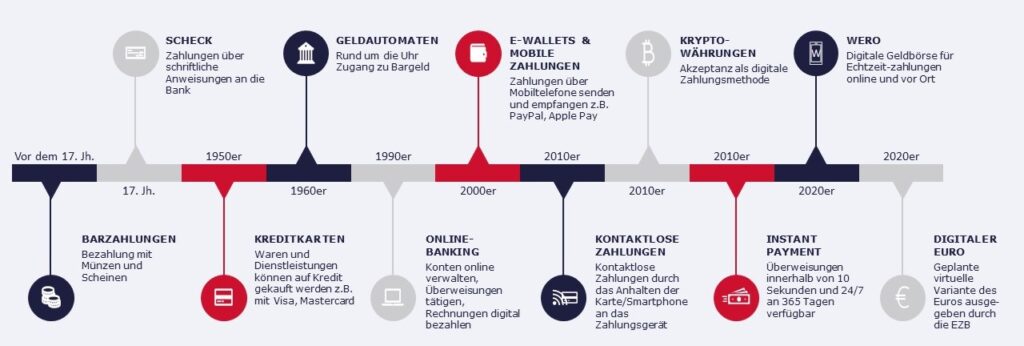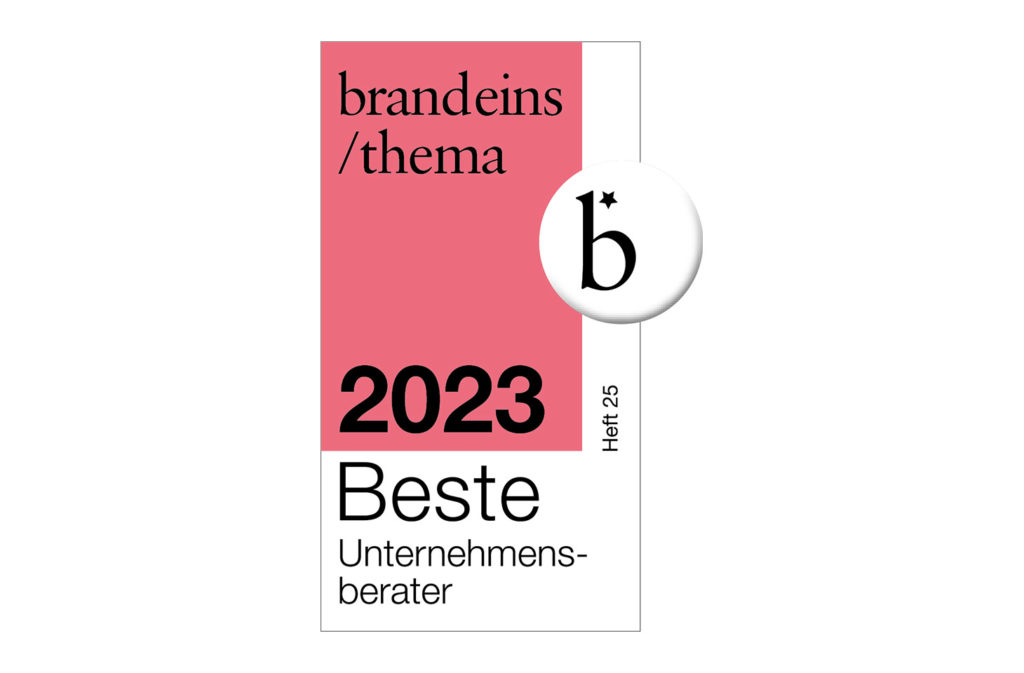Im Zuge des gesellschaftlichen Fortschritts entwickelt sich auch der Zahlungsverkehr kontinuierlich weiter. Zunächst kam bereits vor dem 17. Jahrhundert das Bargeld auf und löste damit den durch Warentausch dominierten Handel ab. Dieses spielt bis heute eine elementare Rolle in unserer Wirtschaft. Ein weiterer Meilenstein war die Einführung von Geldautomaten ab den 1960er Jahren, die einen bequemeren Zugang zu Bargeld ermöglichten. In den 1990er Jahren markierte die Einführung des Online-Bankings und digitaler Überweisungen einen weiteren signifikanten Schritt in der Evolution des Zahlungsverkehrs und verlagerte erste Teile des Bankgeschäfts in die digitale Welt. Der technologische Fortschritt der 2010er Jahre brachte dann die Einführung von grenzüberschreitenden Echtzeit-Zahlungsverkehrssystemen, bekannt als Instant Payments (IP), mit sich. Dies ermöglicht Transaktionen in maximal 10 Sekunden und sorgt somit für die sofortige Verfügbarkeit der Mittel. Es wird erwartet, dass sich Sofortüberweisungen in den kommenden Jahren als Standard etablieren. [15] [25] Parallel dazu hat die zunehmende Nachfrage nach digitalen Zahlungsmethoden und die Notwendigkeit effizienterer Transaktionen Zentralbanken weltweit, einschließlich der Europäischen Zentralbank (EZB), dazu veranlasst, die Einführung von Zentralbank-Digitalwährungen (CBDC) zu prüfen. Folglich entwickeln etwa 100 Zentralbanken eigene digitale Währungen. In diesem Kontext plant die EZB die Einführung des digitalen Euro, wobei Christine Lagarde, Präsidentin der EZB, die Bedeutung dieses Schrittes mit folgenden Worten unterstreicht: „Wir müssen unsere Währung für die Zukunft vorbereiten“, um auf aktuelle und künftige Trends adäquat reagieren zu können. [9][26].

Who accompanies companies competently and reliably through times of crisis? Who helps with the challenges of digital transformation? Every year, the business magazine brand eins selects Germany’s “Best Management Consultants”. Since 2015, we at Consileon have been among the top consulting firms. This year, our performance in the “Banking” sector and in the consulting fields of “Change Management” and “IT Strategy” was recognised.
“For the ninth time, we were able to convince with our commitment, our innovative strength and our know-how,” says Consileon owner and managing director Dr. Joachim Schü. “I am very pleased about the trust and recognition of colleagues and clients.”
brand eins and the statistics portal Statista surveyed more than 8,328 partners and principals (of whom 1967 completed the questionnaire) as well as 200 executives from DAX, S-DAX, M-DAX and Tec-DAX-listed companies and 1,300 executives from other companies. The management consultants had to indicate themselves which colleagues they would recommend, whereby self-nominations were of course excluded. The clients surveyed then assessed the consultancy service providers on the basis of their own experience.
The result: 310 companies and eleven consultant networks made it onto this year’s list of the best and can call themselves “Best Management Consultants 2023”. These come from a total of 16 sectors and 20 fields of work.

Mr. Hientzsch, banks now have to provide information about sustainability when investing money. Is this purely for cosmetic reasons, or do customers benefit from it?
Ralph Hientzsch: It definitely benefits customers if transparency about ESG investments increases in the advisory process. In addition, investors now have to think for the first time and indicate their preference as to which category they fall into: Do they want nothing to do with ESG? Do they want to invest slightly green or really green – in classes 8 and 9, technically speaking.
And what do people ask for?
Ralph Hientzsch: The trend is clearly toward green investments. In 2021, there were already 1.9 trillion euros in category 8 and 9 funds; at the end of April this year, there were 3.3 trillion euros. That corresponds to 45 percent of the total market.
The decentralized approach to finance is redefining the role of exchanges and other intermediaries. Market participants form a network in which it is possible to conduct secured transactions between two or more parties (potentially) worldwide. Distributed ledger technology based on the blockchain approach provides the technological foundation. The blockchain was first described in 2008 in the Bitcoin whitepaper. This was published under the pseudonym Satoshi Nakamoto. The actual inventor remains unknown to this day. The blockchain technology has become known over the years, in addition to Bitcoin, through cryptocurrencies such as Ethereum, Ripple, or Litecoin. Products of the capital market can be represented by the participants of these networks as so-called tokens and defined via smart contracts, which technically implement the properties of the product. This technical representation (cryptoassets) allows market participants to trade and transfer the products in direct exchange with lower hurdles, as well as to receive the monetary equivalent. Due to the technical characteristics (e.g. definition of a consensus algorithm) of the blockchain technology, it is possible for the participants in DLT networks to have their transactions verified by the participants and cryptographically secured. In this way, a decentralized financial network with different participants, who do not necessarily have to know each other, can be established in the vision.
Companies usually collect and store customer data for a specific, predefined purpose in order to then process it exclusively for the same. In addition, IT systems independently generate further data that is not a priori aimed at later processing, so-called metadata. Thus, classic log data is not processed productively as a matter of course, even though a great deal of additional, implied information is hidden in it. With data analytics, it is possible to extract this implied information, interpret it, and use the resulting insights. For this, in addition to a clear data strategy, the necessary methods and expertise are of particular importance. Only with a clear idea of the intended goal can data analytics be used in a targeted manner. The following applies: the more precise the better.
Finding out whether artificial intelligence will be able to support project managers in their day-to-day business in the future – this was the question Consileon Principal Rüdiger Lang addressed with colleagues and scientists from the “Agile Management 4.0” group of the GPM (German Association for Project Management).
The study investigated the answer quality provided by various artificial intelligence offerings with regard to official project management exam questions. The results of the study (downloadable below), presented by Prof. Dr. Helge Nuhn (Professor of Digital Business Engineering at Wilhelm Büchner University in Darmstadt) at the IPMA Research Conference in Belgrade in June 2022, vary widely.
While surprisingly good results were obtained for the artificial intelligence-based software Generative Pre-trained Transformer 3 (GPT-3), other artificial intelligence offerings – such as GPT-Neo or BERT – performed far worse in the analysis conducted. Possible use cases for the use of artificial intelligence in project management were listed as part of the study, but require a deeper analysis. Consideration of the use of artificial intelligence from a social and organizational perspective in project management also requires further in-depth analysis.
For years, ministries and associations have been coming under pressure due to increasing demands on the quality and efficiency of administrative services and declining budgets.
For this reason, the analysis of IT challenges and the introduction of a suitable IT strategy have long been the focus of attention in the healthcare sector.
But: The demands placed on a suitable IT infrastructure are growing. Authorities encounter numerous stumbling blocks when implementing new systems. To remain functional, the IT infrastructure must be combined with a management approach that includes a continuous innovation cycle.
The same is true for changes in work culture. Processes and teams need to become more efficient, agile and innovative to meet new challenges. Leaders and team must be specifically trained in agile methodologies so that ministries can master the transition to a modern work culture.
Modernizing work processes requires extensive expertise to be prepared for tomorrow’s problems today. Consileon draws on a wealth of knowledge and experience from over 20 years and numerous projects in government agencies completed with the highest customer satisfaction.
We are your competent partner for digitalization and realignment to a modern work culture in ministries and associations.
Bestimmt haben Sie schon mal Virtual Reality (VR) gehört, nicht wahr? Diese Technologie ist aber nicht nur dazu da, um am Abend auf der Couch Online-Games zu zocken. VR bietet auch zahlreiche Möglichkeiten und Vorteile im Businesskontext. Brainstormings, Mitarbeitergespräche, Workshops, Präsentationen – all diese Formate funktionieren auch wunderbar in der virtuellen Welt. Sie genießen dabei nicht nur eine ganz besondere Atmosphäre, sondern geben dem Ereignis einen kreativen und individuellen Touch.
Viele Firmen arbeiten remote, ob aufgrund der teils noch andauernden Pandemie-Situation, aus Gründen der Work-Life-Balance oder bedingt durch die zahlreichen Mitarbeitenden an unterschiedlichen Standorten. Oft wird jedoch geklagt, dass darunter Teamspirit und Konzentration leiden. Online-Meetings gestalten sich oft ermüdend und unproduktiv. Zudem fördert das passive Sitzen vor dem Bildschirm nicht gerade die Kreativität, sondern eher die Müdigkeit.
Virtual Reality macht Produkte, Services, Trainings und ganze Unternehmen zum emotionalen Erlebnis und vermittelt Botschaften auf nie dagewesene Weise. Der Betrachter taucht mit einer VR-Brille in eine virtuelle Umgebung ein und hat die Möglichkeit, visuell und auditiv eine völlig neue Welt zu erleben. Es werden (fast) alle Sinne angesprochen. Und genau dies prägt sich besonders in unser Gedächtnis ein.
Das Geniale an VR-Events ist, dass man produktiv und effizient zusammenarbeiten und sich austauschen kann, ohne am gleichen Ort zu sein. Und zugleich herrscht eine unglaublich entspannte Atmosphäre. Da nimmt auch schon mal ein Affe als Maskottchen am Meeting teil. Es wird gelacht und diskutiert, geredet und gelernt, Ideen entworfen und Post-its an die Wand gehängt. Und abschließend trinkt man noch ein gemeinsames Feierabendbier. Virtuell natürlich.
The Handelsblatt Research Institute (HRI) has identified the most renowned consulting companies in various consulting fields. Not only Consileon Business Consultancy GmbH is awarded several times, but also almost all companies of the Consileon Group are listed in the ranking for their areas of expertise.
In times of Corona, supply chain chaos, energy price uncertainties and war turmoil, management consultancies and their clients face major challenges. HRI has investigated who is particularly well equipped to deal with these developments.
“All consultants of the Consileon Group give their best every day to guide our customers as well and safely as possible through these volatile times and to shape the future together. We are very pleased to receive this award from the Handelsblatt and to be recognized for our continuous, trusting cooperation with our customers,” says Joachim Schü, Managing Director and owner of Consileon Business Consultancy GmbH.
For the analysis, HRI first identified a peer group of 15,815 management consultants from 320 consulting firms. This peer group was asked who the most renowned companies were in their respective consulting field. The best in 22 areas were thus identified.
The better the working atmosphere in a company, the better the performance of the employees. At first glance, this seems plausible. But can it be proven – or is it just a gut feeling?
In science, we don’t talk about mood, but about organizational energy. If this is positive (e.g. through fun, motivation and team spirit among employees), the company is significantly more efficient and successful than if the working atmosphere is characterized by frustration, uncertainty and disappointment.
Patricia Unger, project manager at the Center of Competence Business Transformation, took an in-depth look at organizational energy in her master’s thesis. In one area of a globally active industrial company, she was able to use scientific questionnaires to determine the energy level of employees, expose energy traps and suggest concrete measures for improvement, mainly based on employee suggestions.
In summary, the higher the level of productive energy, the faster a company can cope with change, e.g. in times of pandemic and New Work. That is why the topic of Organizational Energy is also part of the spectrum of Consileon’s Business Transformation team.
In this interview, Patricia Unger explains the connection between energy and success – and why managers play an elementary role in this.